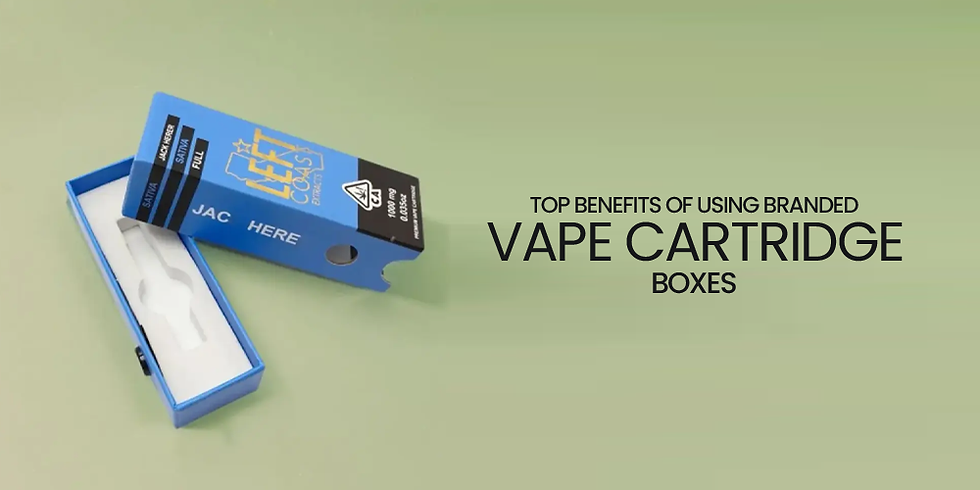Sustainable Packaging Solutions for eCommerce
- teresabutler980
- Feb 26
- 4 min read

The rapid growth of eCommerce has brought convenience to consumers worldwide, but it has also led to significant environmental concerns. Packaging waste, carbon emissions, and excessive use of non-biodegradable materials contribute to pollution and climate change. As sustainability becomes a key focus for businesses and consumers alike, companies must adopt eco-friendly packaging solutions to reduce their environmental footprint.
In this article, we will explore various sustainable packaging solutions for eCommerce, their benefits, and how businesses can implement them effectively.
The Importance of Sustainable Packaging in eCommerce
With millions of packages shipped daily, the impact of packaging waste is substantial. Traditional packaging materials such as plastic, Styrofoam, and excessive paper contribute to landfill overflow and pollution. Sustainable packaging helps mitigate these issues by using environmentally friendly materials, reducing waste, and promoting a circular economy.
Consumers are becoming more conscious of their purchasing decisions, and many prefer brands that prioritize sustainability. According to recent studies, over 70% of consumers are willing to pay more for eco-friendly packaging. This shift in consumer behavior makes sustainable packaging not only an ethical choice but also a competitive advantage for eCommerce businesses.
Key Sustainable Packaging Solutions for eCommerce
1. Recyclable Packaging
Recyclable materials, such as corrugated cardboard, paper, and biodegradable plastics, allow customers to dispose of packaging responsibly. Businesses can ensure their packaging is widely accepted in recycling facilities to encourage proper waste management.
Best Practices:
Use minimal ink and dyes to maintain recyclability.
Opt for cardboard with high post-consumer recycled content.
Provide clear recycling instructions on the packaging.
2. Biodegradable and Compostable Packaging
Unlike traditional plastic, biodegradable and compostable packaging breaks down naturally without harming the environment. These materials include plant-based plastics (PLA), mushroom packaging, and biodegradable mailers.
Benefits:
Reduces landfill waste.
Offers a natural decomposition process without toxic residues.
Appeals to eco-conscious consumers.
3. Reusable Packaging
Many brands are turning to reusable packaging solutions that customers can return and reuse multiple times. Companies like Loop and RePack offer innovative systems where customers send back packaging for future use.
Advantages:
Reduces waste and packaging costs in the long run.
Encourages brand loyalty through sustainable practices.
Lowers carbon footprint associated with single-use packaging.
4. Minimalist Packaging
Reducing unnecessary packaging materials can significantly lower waste and shipping costs. Minimalist packaging focuses on using the least amount of material necessary while maintaining product protection.
How to Implement:
Avoid excessive layers of packaging.
Use right-sized boxes to prevent wasted space.
Eliminate plastic fillers by using paper-based cushioning.
5. Water-Based Inks and Adhesives
Traditional inks contain harmful chemicals that can contaminate recycling processes. Water-based inks, soy inks, and biodegradable adhesives are safer alternatives that enhance sustainability.
Why Choose Water-Based Inks?
Non-toxic and environmentally friendly.
Improve recyclability of packaging materials.
Offer high-quality printing without compromising sustainability.
6. Plant-Based Packaging
Innovative plant-based materials, such as cornstarch packaging, seaweed-based films, and bamboo packaging, provide biodegradable alternatives to plastic. These materials decompose naturally and reduce dependency on fossil fuels.
Best Uses:
Food packaging for eco-friendly takeout options.
Protective wraps and cushioning for delicate eCommerce shipments.
Custom branding with sustainable materials.
7. FSC-Certified Packaging
The Forest Stewardship Council (FSC) certifies paper and wood-based packaging sourced from responsibly managed forests. Using FSC-certified packaging ensures that materials come from renewable sources.
How FSC Certification Helps:
Prevents deforestation and promotes sustainable forestry.
Provides customers with assurance of eco-friendly practices.
Supports ethical supply chains.
8. Smart Packaging Technology
Technology-driven packaging solutions, such as QR codes for digital instructions instead of paper inserts, can help reduce waste while enhancing customer experience. Smart packaging also includes biodegradable RFID tags and water-soluble packaging films.
Benefits:
Minimizes excess printed materials.
Provides interactive customer engagement.
Reduces packaging waste without compromising information delivery.
Challenges in Implementing Sustainable Packaging
While the transition to sustainable packaging is beneficial, businesses often face challenges such as:
Higher Costs: Eco-friendly materials can be more expensive than conventional packaging. However, long-term savings from reduced waste and improved brand loyalty can offset initial costs.
Supply Chain Limitations: Sourcing sustainable materials in bulk can be challenging, especially for small businesses. Partnering with certified suppliers can help overcome this issue.
Consumer Awareness: Educating customers on proper disposal and the benefits of sustainable packaging ensures maximum impact. Including sustainability messaging on packaging can enhance consumer engagement.
How eCommerce Brands Can Transition to Sustainable Packaging
1. Assess Current Packaging Practices
Evaluate your existing packaging materials and identify areas for improvement. Conduct a life cycle assessment (LCA) to measure the environmental impact of your packaging choices.
2. Partner with Sustainable Packaging Suppliers
Work with packaging providers who offer eco-friendly alternatives. Look for certifications such as FSC, Cradle to Cradle, and BPI compostability standards.
3. Optimize Packaging Design
Design packaging with sustainability in mind by reducing excess material, using biodegradable adhesives, and incorporating minimalist branding.
4. Educate Consumers
Encourage responsible disposal of packaging by providing clear recycling or composting instructions. Brands can also launch sustainability awareness campaigns to highlight their commitment.
5. Offer Incentives for Sustainable Choices
Reward customers for choosing sustainable packaging options. Programs like discounts for returning reusable packaging or loyalty points for eco-friendly purchases can drive engagement.
Conclusion
Sustainable packaging solutions for eCommerce are no longer just an option—they are a necessity. As consumer preferences shift towards eco-conscious brands, businesses that adopt recyclable, biodegradable, reusable, and minimalist packaging solutions will stand out in the competitive market.
By investing in sustainable packaging, eCommerce brands can reduce environmental impact, enhance brand reputation, and contribute to a greener future. The transition may come with challenges, but the long-term benefits make it a worthwhile investment for both businesses and the planet.
Would you like me to tailor this article to a specific niche or audience within eCommerce? Let me know how I can refine it further!
Recent Posts
See AllIntroduction That dusty, dented vehicle in your driveway might look useless, but it’s actually a source of instant income. Junk car for...











Comments